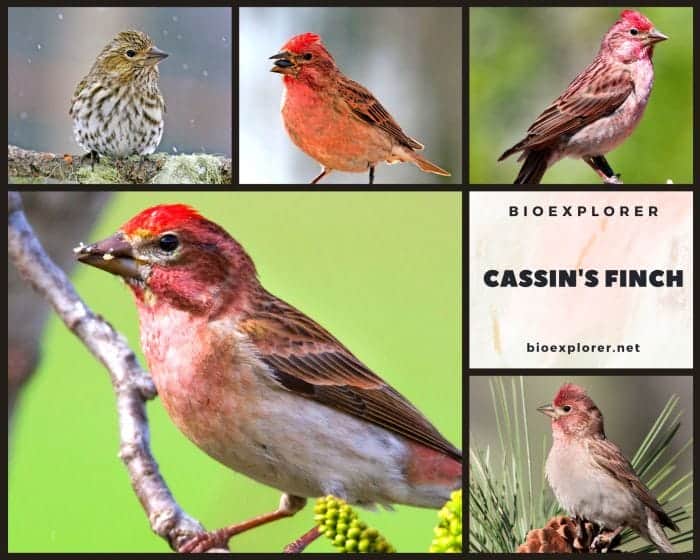
| Animalia | Aves | Passeriformes | Fringillidae | Chordata | Haemorhous cassinii |
The Cassin’s Finch (Haemorhous cassinii) is a charismatic songbird breeds predominantly in western North America’s mountain forests. Named after pioneering 19th-century American ornithologist[1] John Cassin, this finch species stands out thanks to its complex vocalizations, irregular migratory movements, and ability to inhabit diverse high-elevation habitats from pine forests to open scrublands.
While the Cassin’s Finch resembles more familiar finch species like the Purple Finch and House Finch, it has several unique physical traits and behaviors that set it apart from its relatives. Gaining a deeper understanding of the Cassin’s Finch provides valuable insights into finch biology, adaptation to montane environments, and the intricacies of coniferous forest ecosystems in the Mountain West.
Some key attributes that make Cassin’s Finch special include:
- Distinct male breeding plumage featuring a rosy pink body and bright red crown.
- A lively, complex warbling song very different than other finch species.
- Nomadic movements and irregular winter migrations in search of widely dispersed food.
- Ability to thrive across a diversity of western habitats and elevations.
- Important relationships with conifers for food, nest sites, and seed dispersal.
Learning more about this adaptable western mountain species can shed light on the ecology of the finch family and the avian diversity found in Rocky Mountain habitats. With increased study, the Cassin’s Finch can serve as an indicator species for the impacts of climate change and other environmental threats within its high-elevation forest homes.
Table of Contents
- What Makes Cassin’s Finch Unique?
- Identification and Physical Characteristics
- Habitat and Distribution
- Behavior and Social Structure
- Fun Facts about Cassin’s Finch
- Conservation Status
- Importance to Ecosystems
- Frequently Asked Questions
- Where does the Cassin’s Finch nest?
- How can Cassin’s Finch be identified in the field?
- What is the difference between the Cassin’s Finch and the Purple Finch?
- What are some common characteristics of the Cassin’s Finch?
- How can I add the Cassin’s Finch to my bird list?
- What does ‘cassinii’ mean in the name Cassin’s Finch?
- What is the behavioral pattern of the Cassin’s Finch during the fall?
- What species are similar to the Cassin’s Finch?
- How has the Cassin’s Finch been represented in scientific studies?
- What is the range map for Cassin’s Finch (Carpodacus cassinii)?
- How can I identify a Cassin’s Finch in a field guide?
- What are the key features for Cassin’s Finch identification?
- How can I distinguish between male and female Cassin’s Finches?
- What is the preferred habitat of Cassin’s Finch?
- What do Cassin’s Finches eat?
- How can I attract Cassin’s Finches to my backyard?
- What is the nesting behavior of Cassin’s Finches?
- Conclusion
What Makes Cassin’s Finch Unique?
The Cassin’s Finch has several distinctive traits that set it apart from other finch species that share its western mountain habitats.
Plumage
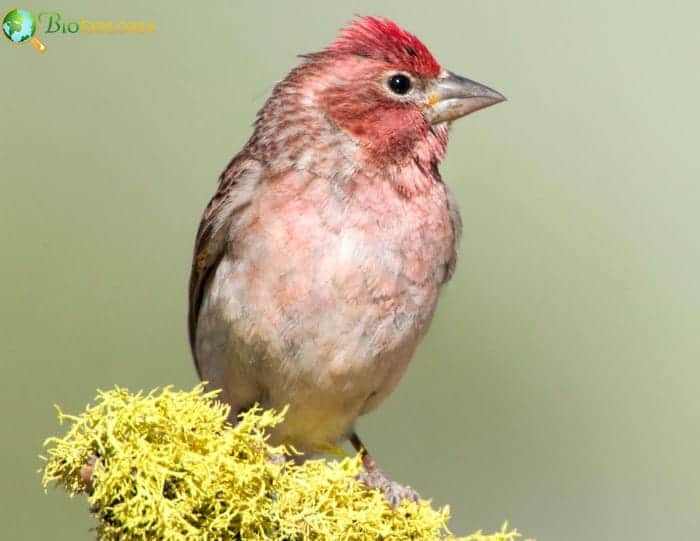
Adult male Cassin’s Finches have uniquely colored plumage, a bright rosy pink body contrasting with dull brown streaking on the breast and flanks. Their crowns are a rich reddish-orange not seen on other similar finches. Females are nondescript gray-brown with heavy streaking.
![]()
Song and Calls
The male Cassin’s Finch sings a complex, rapid warbling song that sounds noticeably different from other finch species in the same genus, like the Purple Finch or House Finch. Their buzzy call notes are also unique.
![]()
Movements
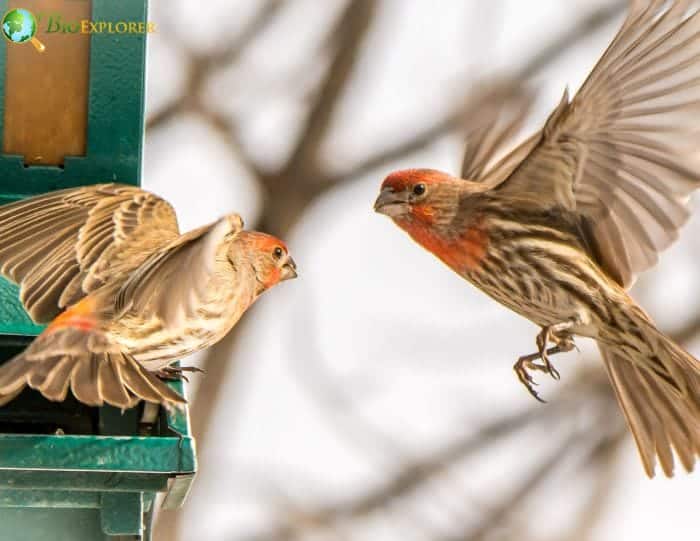
Unlike most finches that migrate along predictable routes, Cassin’s Finches are nomadic and wander irregularly in search of food instead of following a set seasonal path. This makes their movements more dynamic.
![]()
Habitat Flexibility
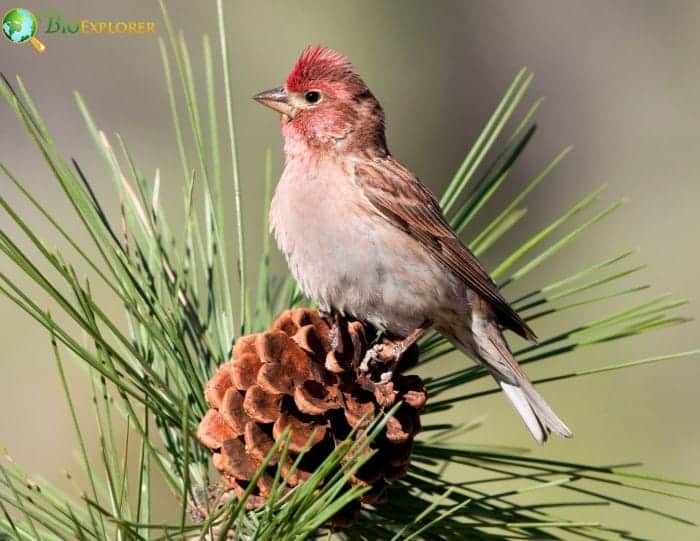
Cassin’s Finches can thrive across a wider range of forest types and elevations than other finch species, from pine forests down to scrub oak woodlands. This adaptability allows them to take advantage of multiple montane habitats.
These specialized traits likely help the Cassin’s Finch flourish across the varied and often harsh environments within its western mountain breeding range by using widely dispersed resources[2].
![]()
Identification and Physical Characteristics
The Cassin’s Finch averages 5.7 to 6.1 inches in length and displays notable differences in plumage and physical features compared to similar finch species.
Size and Shape
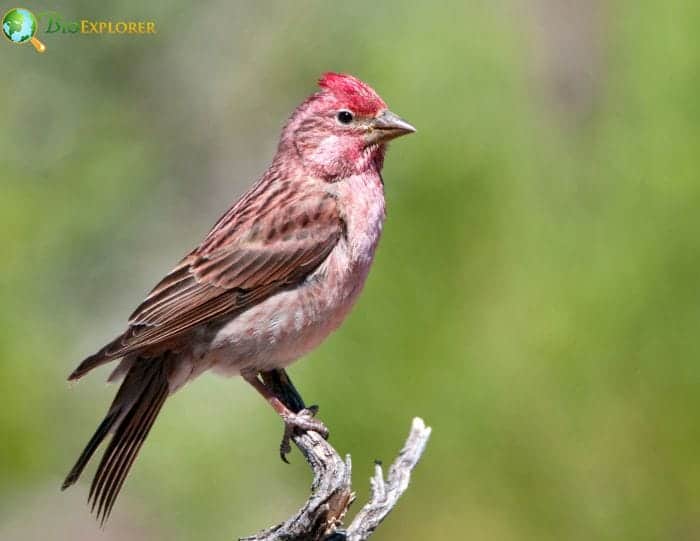
- The Cassin’s Finch measures 5.7 to 6.1 inches long[3] and weighs approximately 0.6 ounces on average. This makes it a small-bodied finch, though slightly larger than the House Finch.
- It has a plump, conical bill shape well-adapted for crushing hard seeds and husks. The profile shows a rounded, full head.
- Cassin’s Finches display the typical short, notched tail and rounded wing shape characteristic of the finch family. Their wings allow agile flight through dense pine forests.
![]()
Plumage and Coloration
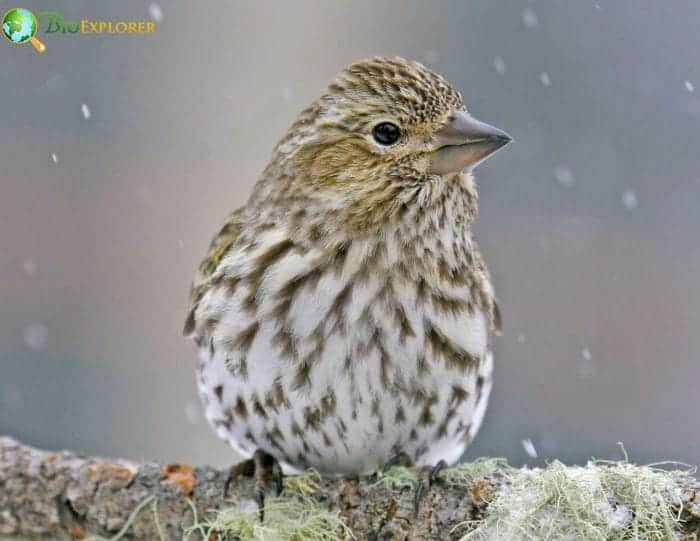
- Adult male Cassin’s Finches are brightly colored with rosy pink bodies, dull brown streaking on the breast and flanks, and rich reddish-orange crowns. Their sharply peaked head profile is distinctive.
- Females have nondescript, heavily streaked gray-brown plumage overall with a muted white belly. They lack the male’s bright colors and bold head profile.
- Juveniles resemble adult females but are even more heavily streaked below with pale brown and diffuse streaking on their underparts. Their plumage is muted like females.
- Males can be distinguished from similar finch species by their rosy pink body plumage and bright reddish-orange crown. Females are very difficult to differentiate from other female finches.
![]()
Bill and Tail Features
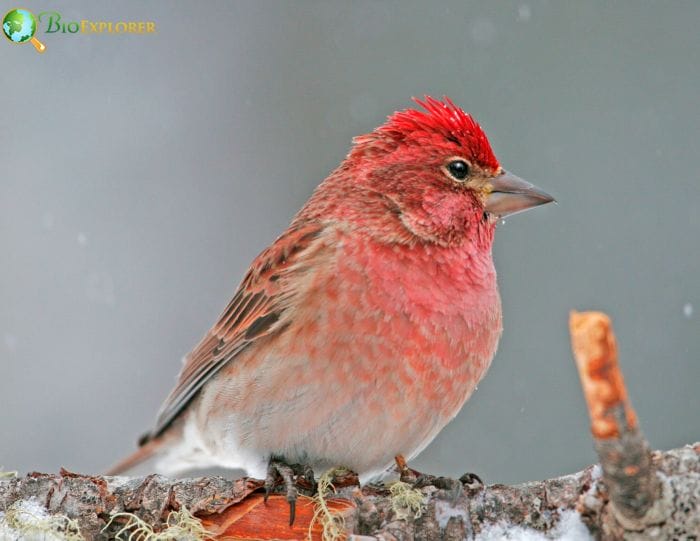
- Cassin’s Finches have short, conical bills that are dark on the upper mandible and yellow on the lower mandible. This aids them in cracking tough conifer seeds.
- Their tails are slightly notched or forked, with dark central tail feathers and white outer tail feathers, a pattern seen in many finch species.
- Their short wings provide an agile flight for navigating dense conifer stands and chasing after loose flocks.
![]()
Juvenile vs. Adult Features
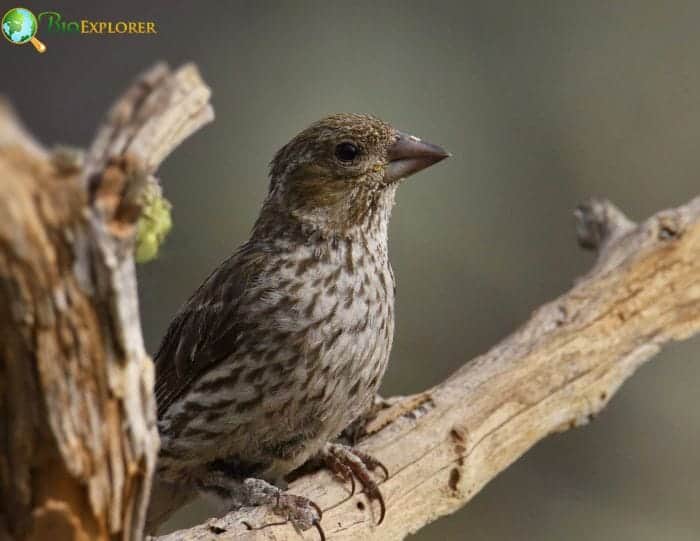
- Juvenile Cassin’s Finches are heavily streaked overall, with pale underparts and none of the distinctive colors of adult males. This heavy streaking provides camouflage.
- Adult male Cassin’s Finches develop bright rosy pink plumage with rich orange-red crowns on their bodies. Their sharply peaked head profile is a key identifier.
- Adult females retain the nondescript gray-brown plumage of juveniles but with finer streaking on the underparts. They lack any pink or distinctive markings.
- Differentiating adult females and juveniles in the field can be very challenging. Subtle clues include more diffuse streaking and paler bellies in juveniles.
![]()
Habitat and Distribution
The Cassin’s Finch occupies diverse habitats across mountainous regions of western North America.
Natural Habitat
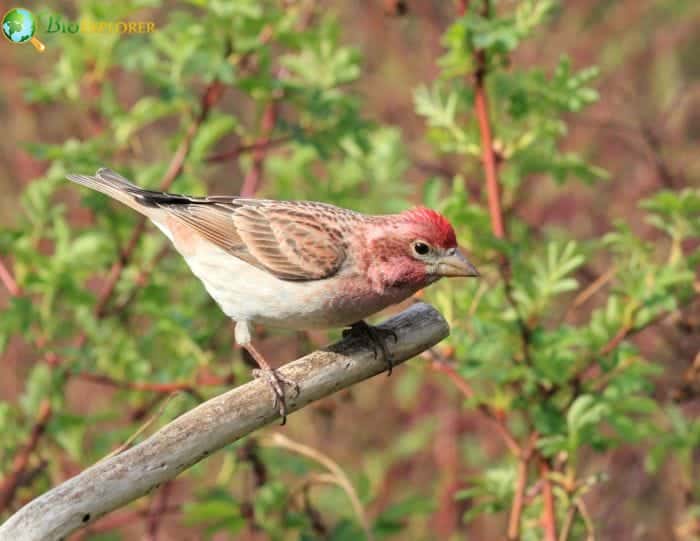
- During breeding, Cassin’s Finches are found in lodgepole pine and mixed coniferous forests, aspen groves, and riparian woodlands at elevations between 4, 000-10, 000 feet.
- They nest in tall, mature conifers within these mountain forest habitats, including pine, fir, and spruce trees. The trees provide nest sites and food through seeds and buds.
- In the non-breeding season, Cassin’s Finches move to lower elevations in the foothills and valleys. They frequent open pine-oak woodlands, pinyon-juniper forests, and scrubby areas.
- Wintering finches will readily visit bird feeders stocked with sunflower seeds, especially when natural food is scarce. Both coniferous and broadleaf trees are important foraging habitats.
![]()
Geographic Distribution
- The Cassin’s Finch breeds in mountainous regions[4] from southeast Alaska and western Canada south along the Pacific Coast ranges to California, Arizona, and New Mexico.
- Its breeding range is somewhat localized in pockets across this broader region wherever suitable conifer forest habitat exists. It does not occupy the mountain West uniformly.
- During winter, Cassin’s Finches vacate their high-elevation breeding zones and move variably south and downhill to lower elevations. Their winter range extends as far south as northwest Mexico.
- Winter movements are nomadic and unpredictable as the finches wander in search of food rather than following a set migratory path. Flocks may appear anywhere from the Pacific Northwest to the Southwest if food is abundant.
- Cassin’s Finches sometimes irrupt well outside their normal range if food sources diminish on their western mountain breeding grounds. However, these irruptions are sporadic, and populations quickly retreat once conditions improve.
- Generally, this species is endemic to the western mountain ranges and rarely strays far into North America’s eastern or central regions. But vagrants can turn up if the finches wander.
![]()
Behavior and Social Structure
The Cassin’s Finch exhibits complex social behaviors and adaptations for thriving in western mountain environments.
Feeding Habits
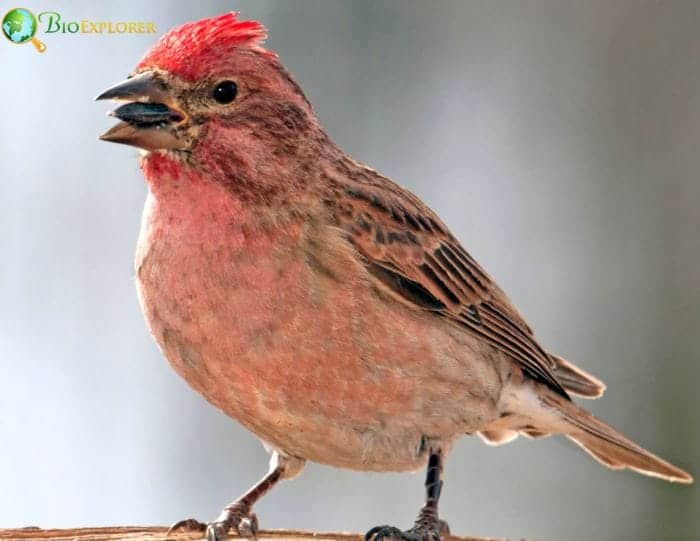
- Cassin’s Finches largely feed on conifer seeds from species like pine, fir, and spruce. They use their specialized beak to extract and husk these small, tough seeds.
- They also feed on flower buds, berries, fruits, and some insect prey to supplement their seed-heavy diet. Cassin’s Finches forage actively in trees and hang upside-down to reach cones and foliage.
- These finches form loose nomadic flocks outside of the breeding season, ranging widely in search of productive food sources. Their movements are closely tied to the annual cycle of seed production.
- When cone crops are poor in their mountain habitat, Cassin’s Finches may wander more widely in large numbers to find food. These irruptive movements make their winter range very dynamic.
![]()
Mating and Nesting
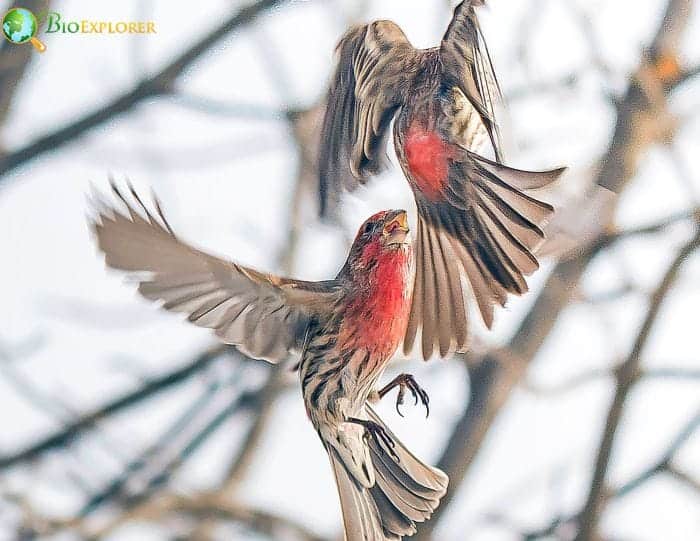
- Cassin’s Finches form monogamous breeding pairs across their mountain forest range between May and early July.
- Courting males sing and display to attract females. Once paired, couples build an open cup nest high up in a conifer tree on a horizontal branch.
- The female lays a clutch of 4-5 eggs which she incubates for about two weeks while being fed by her mate. Both parents feed the nestlings.
- Young fledge from the nest around 17 days after hatching but remain dependent on their parents for 3-4 weeks as they learn to forage.
- Pairs may raise more than one brood per breeding season. Brown-headed Cowbirds sometimes parasitize nests.
![]()
Social Interactions
- Cassin’s Finches form flocks outside the breeding season and mix freely with other finch species while foraging and migrating.
- Nesting pairs maintain distinct breeding territories but may associate with nearby pairs after eggs hatch to form loose colonies, jointly defending resources.
- Young birds disperse variable distances after gaining independence to establish their own breeding or wintering territories. Dispersal distances likely depend on population density.
- Cassin’s Finches benefit from flocking behavior while foraging, as many birds searching together can more easily locate sporadic food sources across the landscape.
- Flocks break up into breeding pairs come spring. These complex social interactions allow Cassin’s Finches to thrive in challenging montane environments.
![]()
Fun Facts about Cassin’s Finch
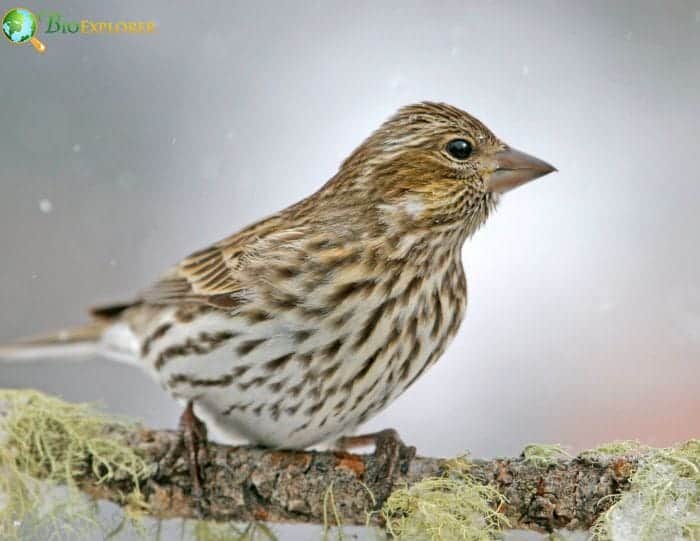
- Cassin’s Finches have a complex, rapid warbling song that sounds almost canary-like compared to other finches. Researchers have recorded over a dozen distinct song types.
- They have a unique vocal organ called the syrinx that allows them to sing two notes simultaneously, something few other songbirds can do.
- Cassin’s Finches have been recorded mimicking sounds like camera shutters, dogs barking, and even human speech.
- While finches are seed-eating specialists, Cassin’s Finches occasionally prey on small insects like aphids and caterpillars to feed their young.
- Their scientific name “cassinii” honors early American naturalist John Cassin, who first described the species from a specimen collected in 1852.
- Unlike most finches, Cassin’s Finches remain together in male-female pairs throughout the winter when most other finches form larger mixed flocks.
- Brown-headed Cowbirds occasionally parasitize Cassin’s Finch nests, but this finch is more resistant to brood parasitism than many other species.
- Biologists think the Cassin’s Finch’s ability to thrive across diverse habitats from pine forests to scrublands helps them survive the variable conditions in mountain environments.
- Young Cassin’s Finches develop colorful adult plumage through a complete molt around 4 months after hatching. Their drab juvenile feathers are entirely replaced.
- Cassin’s Finches store seeds in specialized expandable gular pouches in their throats. This allows them to gather and transport lots of seeds at once.
![]()
Conservation Status
The Cassin’s Finch has a large range, and populations appear stable currently, though more research is needed.
Current Status
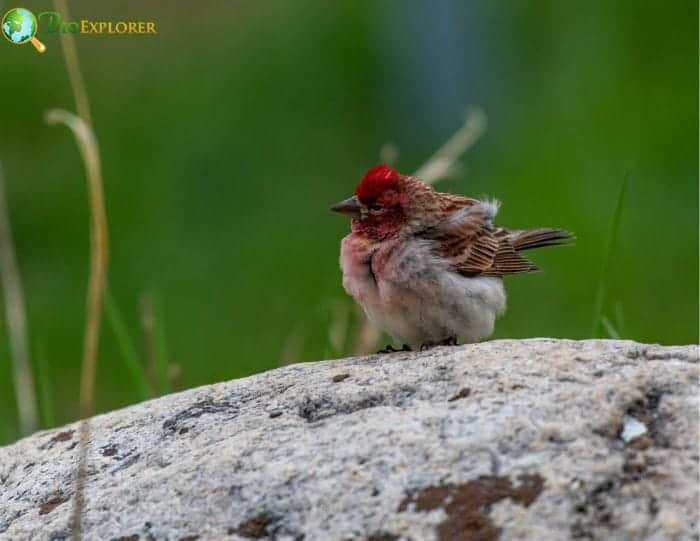
- The Cassin’s Finch has been evaluated as Least Concern[5] on the IUCN Red List due to its large breeding range and population.
- Partners in Flight estimates a global population of 5 million, with the vast majority in the United States and Canada. Numbers appear to be stable long-term.
- Due to its remote mountain habitat, large overall numbers, and lack of significant threats, the Cassin’s Finch is considered a species of low conservation concern.
- However, Breeding Bird Survey data shows a small but statistically significant population decline of about 1% annually across its range since the 1960s.
- The Cassin’s Finch adapts readily to human presence and is a common visitor to backyard bird feeders, especially in winter. This has likely benefited the species.
![]()
Threats and Challenges
- Habitat loss is not a major concern, but climate change may alter montane forests and impact food sources like cone crops. Long-term monitoring is needed.
- Brood parasitism by Brown-headed Cowbirds can reduce reproductive success, but Cassin’s Finches are less prone to heavy cowbird parasitism than many other species.
- The greatest knowledge gap is understanding populations and distribution at the edges of their range. BBS data quality is poor in some remote areas.
- Contact with backyard bird feeders may increase disease transmission risk for Cassin’s Finches congregating over food sources. Feeders should be kept clean.
- Catastrophic forest fires due to climate change pose a potential future threat, but the impacts on Cassin’s Finches are poorly understood and require study.
Overall, the Cassin’s Finch appears to be a resilient species, but changes in montane habitat could affect its status. Ongoing monitoring of populations across its range is recommended.
![]()
Importance to Ecosystems
The Cassin’s Finch is important in seed dispersal, pollination, and other ecosystem services in western mountain habitats.
Role in Food Chain
- As a consumer of conifer seeds and buds, the Cassin’s Finch affects predator-prey relationships in the conifer forest food web. Finch populations are also limited by food availability.
- Cassin’s Finches are preyed upon by sharp-shinned hawks, Cooper’s hawks, and other woodland raptors. Nest predation can come from jays, squirrels, and chipmunks.
- By dispersing and caching uneaten conifer seeds, the finches influence the regeneration and growth of pine, fir, and spruce trees. This provides a food source for future generations.
- Their numbers fluctuate irruptively based on conifer cone crop yields. This influences seed dispersal rates.
![]()
Impact on Plant Life
- The Dana Cassin’s Finch contributes to the pollination of high-elevation plant species by feeding on flowers and carrying pollen between plants.
- Its seed dispersal role aids conifer reproduction and regeneration, particularly across remote mountain terrain with limited seed transport.
- Caching excess seeds contributes to new seedling establishment away from the parent tree. This may broaden the forest habitat over time.
- By feeding on berry and fruit crops, Cassin’s Finches aid in the wider dispersal of the seeds. Their nomadic habits allow long-distance transport.
- Flocking and foraging behaviors can impact mature trees through buds, seeds, and flowers consumed, but no major negative effects have been documented.
Overall, the interdependent relationship between Cassin’s Finches and their coniferous forest ecosystem influences plant communities and food webs.
![]()
Frequently Asked Questions
Where does the Cassin’s Finch nest?
Cassin’s Finch typically nests in coniferous trees such as the ponderosa pine or quaking aspen. They build nests using twigs and rootlets. It’s important to note that the breeding habitat of this species changes from year to year.
How can Cassin’s Finch be identified in the field?
A popular field guide like eBird or the Field Guide to North American Birds can be indispensable for identification. The Cassin’s Finch is a characteristic rosy-tinged finch with notable differences in the undertail coverts compared to other finches.
What is the difference between the Cassin’s Finch and the Purple Finch?
The Carpodacus Cassinii and Carpodacus Purpureus, more commonly known as the Cassin’s Finch and the Purple Finch, respectively, have distinctive characteristics. Especially noticeable is the heavier streaking on the sides of the female and immature Cassin’s Finch than in Purple Finch. Plus, the undertail coverts in Cassin’s are whiter.
What are some common characteristics of the Cassin’s Finch?
The Cassin’s Finch, also known as Carpodacus Cassinii, is noted for its reddish plumage and the streaking on the sides of females and immature birds. They are often seen in small flocks in the mountains of Western North America.
How can I add the Cassin’s Finch to my bird list?
To tick off the Cassin’s Finch on your bird list, one of the prerequisites would be to monitor their common habitats, such as ponderosa pine or quaking aspen forests in the mountains of Western North America. Field guides and services like eBird, Birds of North America Online can help to accurately identify this species.
What does ‘cassinii’ mean in the name Cassin’s Finch?
‘Cassinii’ in Carpodacus Cassinii, named after John Cassin, is the species epithet. This name signifies the species in the Carpodacus genus this bird represents. It’s a common naming convention in ornithology.
What is the behavioral pattern of the Cassin’s Finch during the fall?
Fall departure in Cassin’s Finch is a phenomenon where these birds disperse from their summer mountain habitats to lower elevations. This pattern, however, is not consistent and can vary depending on multiple factors, including weather and food availability.
What species are similar to the Cassin’s Finch?
Species similar to the Cassin’s Finch or Carpodacus Cassinii include the Purple Finch and the Crossbill. While they share similar habitats and some overlapping traits, they also have distinguishable characteristics, particularly in terms of undertail coverts and female and immature bird coloration.
How has the Cassin’s Finch been represented in scientific studies?
The Cassin’s Finch has been the subject of numerous scientific studies over the years, including those published in journals like the Condor. These studies have contributed significantly to understanding the bird’s breeding, migratory patterns, and the impact of habitat changes on the range of the species.
What is the range map for Cassin’s Finch (Carpodacus cassinii)?
Cassin’s Finch is found in western North America, primarily in tall evergreen forests. Their range extends from southern British Columbia to northern New Mexico. During winter, they may move to lower elevations and can be found as far south as northern Mexico. The Cornell Lab of Ornithology and eBird provide detailed range maps for this species.
How can I identify a Cassin’s Finch in a field guide?
In a field guide, look for a small finch with a distinctively shaped bill. Adult males are rosy pink overall, with a bright red crown and a brown-streaked back. Females and immature birds are streaked with brown and have a subtle yellow wash. The species is often confused with House Finches and Purple Finches, so pay attention to subtle differences in coloration and bill shape.
What are the key features for Cassin’s Finch identification?
Key features for Cassin’s Finch identification include: a slightly larger size compared to House Finches, a longer and straighter bill, and a less rounded head. Adult males have a bright red crown, rosy pink coloration on the head, breast, and rump, and brown streaking on the back. Females are streaked with brown and have a subtle yellow wash. Both sexes have dark wings with two pale wing bars.
How can I distinguish between male and female Cassin’s Finches?
Sex differentiation in Cassin’s Finches is relatively straightforward. Adult males are rosy pink overall with a bright red crown, while females are streaked with brown and lack the rosy coloration. Females have a subtle yellow wash and more prominent streaking on their underparts. Immature males look like females for their first year before developing adult male plumage.
What is the preferred habitat of Cassin’s Finch?
Cassin’s Finches prefer tall evergreen forests, particularly those dominated by pine, fir, and spruce Trees. They are often found in open coniferous forests at higher elevations during the breeding season. In winter, they may move to lower elevations and can be found in a variety of habitats, including deciduous woodlands, orchards, and even suburban areas with appropriate food sources.
What do Cassin’s Finches eat?
Cassin’s Finches primarily feed on buds and seeds. They forage in trees and on the ground, eating a variety of seeds from conifers and other plants. They are particularly fond of the buds of quaking aspen. During winter, they may visit sunflower seed feeders in residential areas. Their diet also includes some insects, especially during the breeding season when they need extra protein.
How can I attract Cassin’s Finches to my backyard?
To attract Cassin’s Finches to your backyard, especially during winter, provide sunflower seed feeders. These birds are particularly fond of black oil sunflower seeds. You can also plant native coniferous trees and shrubs that produce seeds. Maintaining a water source, such as a bird bath, can also help attract these and other bird species to your yard.
What is the nesting behavior of Cassin’s Finches?
Cassin’s Finches typically nest in coniferous trees, building a cup-shaped nest made of twigs, grass, and rootlets. The female usually lays 4 to 5 eggs, which she incubates for about 12-14 days. Both parents feed the nestlings, and the young fledge after about two weeks. After fledging, parents and young may stay together in small family groups for a short period before joining larger flocks.
Conclusion
In conclusion, Cassin’s Finch is a unique and adaptable songbird that thrives across western North America’s mountain forests and high-elevation habitats. Despite similarities to other finch species, the Cassin’s Finch has distinctive plumage, vocalizations, social behaviors, and habitat preferences that set it apart.
This species plays an important role in its ecosystem by dispersing and planting conifer seeds, participating in complex food webs, and pollinating high-elevation plant species. While Cassin’s Finch populations appear stable currently, they face potential threats from climate change, forest fires, and habitat alteration. Long-term monitoring across their mountain range will be key to conserving this species.
Gaining a better understanding of Cassin’s Finch provides insights into finch biology, adaptation to montane environments, and the intricacies of coniferous forest ecosystems.
Cassin’s Finch’s resilience and adaptability could make it an important indicator of climate impacts and forest changes in the Mountain West. With increased conservation attention, this unique songbird will hopefully continue thriving across its rocky mountain strongholds for centuries.
















